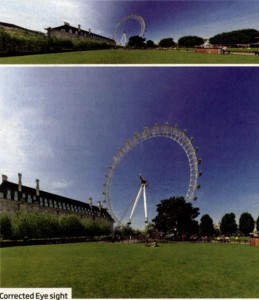Opinion
Scientists and the Perspective of View-painters
New Scientist (26 June 2010, p. 21) has recently reported on a scientific study of the perspective used by eighteenth-century view painters (vedutisti). The team, headed by Thomas Sharpless, a retired software engineer in Philadelphia, picked 14 vedute of the interiors of buildings for which they had ground plans. ‘They identified 20 points in each painting and located them on the corresponding plan. They then used this information to create a mathematical projection function and incorporated it into a piece of software, called “Panini”.’ No prizes for guessing which painting(s) and which building features prominently! The article goes on to state that ‘Panini [the program] can squash the width of a panoramic image while retaining perspective.’ Quite what this means is far from clear. It seems to assume that all 14 paintings employ the same perspective, which would be right in the sense that all would employ central-point perspective. The preamble states that the vedutisti ‘had excelled at wide-angle views of Italian cities that appeared to preserve perspective completely.’ What might this mean? A perspective construction can be anything from wide angle to telephoto depending on the viewing distance chosen. It is rather tautological to state that such a picture ‘preserves perspective completely’. Or is the photographic fallacy creeping in here? That the painting is a ‘photo’ to which some kind of perspectival filter is applied to make it a wide-angle view, which can then be given a normal viewpoint through a Photoshop-type filter? This seems to be confirmed by the next sentence, which states that ‘they couldn’t have done this with the rectilinear method of capturing perspective that most camera lenses use, he reasoned.’ The illustrations show a ‘rectilinear version’ of a ‘180 degree panorama of the London Eye’ and a version of the same that has been corrected with ‘Panini’. So the issue is about curvature, and presumably related to the old ‘little pictures’ issue about the need to have a curved projection plane to match a curved visual field. The transformation of the image shown is quite complex. It will be interesting to see the details of this study.
Panini’s views of St Peter’s employ impossible view-points, but look as if the perspective is perfectly linear, although, as with Pieter Saenredam, there may be shifts of viewpoints employed for the higher parts. His views of the Palazzo Farnese interior, like the St Peter’s, simply removes the near wall; the first thing you see is in fact the first element in the interior, but from then on it is a straightforward perspective construction. His views of the Pantheon are often quite squishy, and look as if they employ a ground plan constructed in perspective, combined with a largely empirical rendering of the elevations and dome. As far as I have been able to observe, there is never any vertical convergence or curvature of straight lines: the columns and pilasters are vertical, but cornice lines tend to be all over the place, as you would expect if he worked empirically.
© David R. Marshall 3 July 2020
Link to article ‘Wide-angle photos put in realistic perspective’, 23 June 2020 (Magazine issue 2766) – Link. (You will need to be a subscriber to view the entire article)
Link to Giovanni Paolo Pannini, The Interior of the Pantheon in Rome, 1735 – Link.
Link to Giovanni Paolo Pannini, The Interior of St Peter’s, Rome, after 1754 – Link.

